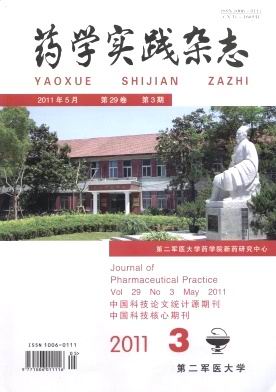QIN Chang-xin, FU Qiu-sheng. Analysis of prescriptions in military personnel outpatients[J]. Journal of Pharmaceutical Practice and Service, 2011, 29(3): 229-231.
| Citation:
|
QIN Chang-xin, FU Qiu-sheng. Analysis of prescriptions in military personnel outpatients[J]. Journal of Pharmaceutical Practice and Service, 2011, 29(3): 229-231.
|
Analysis of prescriptions in military personnel outpatients
- Received Date: 2010-06-07
- Rev Recd Date:
2010-12-30
-
Abstract
Objective To analyze the rationality and status of drug utilization in military personnel outpatients by the index of rational drug use recommended by WHO. Methods 3000 prescriptions from Match to December in 2009 were randomly collected and analyzed by statistical methods. Results The average number of drugs per prescription was 3.2, the average drug expenditure per prescription was 113.3 yuan. There were 40% of those prescriptions which was over than 100 yuan. 5% of those prescriptions were injection drugs. The use rate of cardiovascular drugs was 35%, which were mainly calcium antagonists (18%) and ACEI (13%). Prescriptions of antibiotics were 33% which could be further standardized. All drugs were prescribed by generic name which were listed in Military Personnel Drug Directory for General Hospitals. 9% of prescription were irrational including prescriptions without proper indications, unreasonable dosage and administration, ect. conclusion The drug utilization in military personnel outpatients was basically rational. The utilization of antibiotics should be further standardized.
-
References
|
[1]
|
国家药典委员会. 中华人民共和国药典·临床用药须知[S].2005年版. 北京:人民卫生出版社,2005. |
|
[2]
|
International Network for Rational Use of Drugs and World Health Organization. How to investigate drug use in health facilities: Selected drug use indicators. EDM Research Series No. 7[WHO/DAP/93.1]. Geneva: World Health Organization, 1993. |
|
[3]
|
王慧媛,赵志刚,陈 丽. 我院门诊处方合理用药指标调查分析[J]. 中国医院用药评价与分析,2009,9(9):669. |
|
[4]
|
Katja T,Nick B. Ethnographic study of incidence and severity of intravenous drug errors[J]. BMJ,2003,32(6):684. |
|
[5]
|
Kunin CM. The responsibility of the infectious disease community for the optimal use of antimicrobial agents[J]. Journal of Infectious Diseases,1985,151(3):388. |
|
[6]
|
汪立淋. 患者用药的依从性问题[J]. 中国医院药学杂志, 1995,15(7):344. |
|
[7]
|
阎峻蜂. 主要抗菌药物的利用调查[J]. 药物流行病学杂志,1997,6(2):96. |
|
[8]
|
梁奕宏,柳 红. 滥用抗生素导致疾病和死亡的社会问题[J]. 中国检验检疫,2004,10(1):59. |
|
[9]
|
张延伟,张士勇. 我院2008年门急诊处方分析[J]. 安徽医药,2010,14(9):1087. |
|
[10]
|
王慧媛, 田德蔷,赵志刚. 我院门诊处方合理用药指标干预调研[J]. 中国药房,2008,19(20):1592. |
|
[11]
|
陈 文,沈百余,杨毓瑛. 不合理用药分析200例[M].第2版. 上海:上海科学技术出版社,1992.101. |
|
[12]
|
张安年,梁民琦. 临床常见非合理用药[M]. 北京:人民卫生出版社, 2000:139. |
|
[13]
|
卫生部. 处方管理方法[S]. 2007-02-14. http://www.gov.cn/ziliao/flfg/2007-03/13/content-549406.htm. |
|
[14]
|
卫生部. 国家中医药管理局.总后卫生部.抗菌药物临床应用指导原则[S]. 卫医发 |
|
[15]
|
285号,2004:11. |
|
[16]
|
卫生部办公厅. 关于进一步加强抗菌药物临床应用管理的通知[S]. 卫办医发 |
|
[17]
|
48号,2008. |
|
[18]
|
卫生部. 医院处方点评管理规范(试行)[S]. 卫医管发〔2010〕28号,2010,2,10. http://www.gov.cn/gzdt/2010-03/04/content_1547080.htm. |
-
-
Proportional views

-







 DownLoad:
DownLoad: